TOYOTA BZ4X 2022 Owners Manual (in English)
Manufacturer: TOYOTA, Model Year: 2022, Model line: BZ4X, Model: TOYOTA BZ4X 2022Pages: 674, PDF Size: 120.02 MB
Page 541 of 674
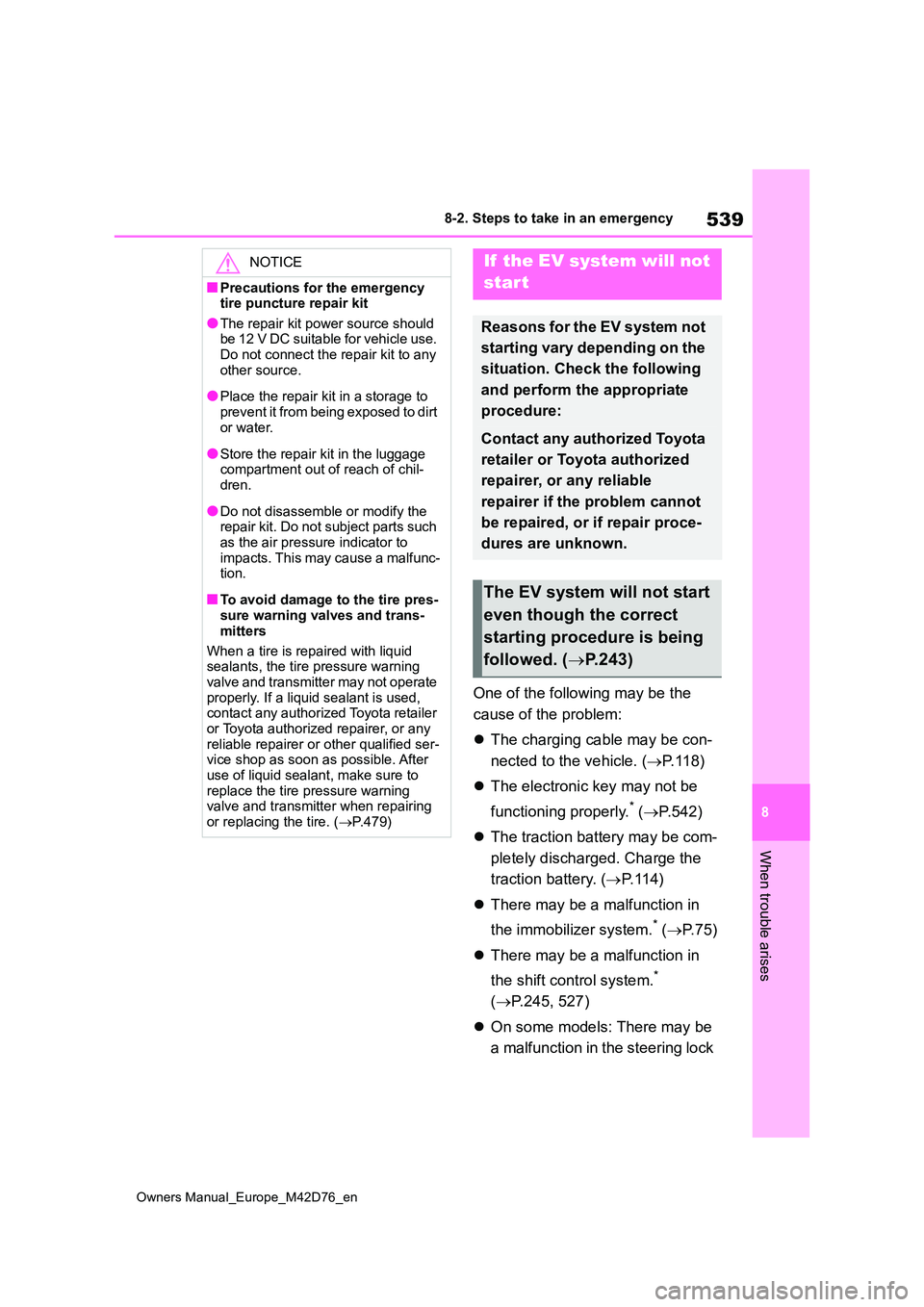
539
8
Owners Manual_Europe_M42D76_en
8-2. Steps to take in an emergency
When trouble arises
One of the following may be the
cause of the problem:
The charging cable may be con-
nected to the vehicle. ( P.118)
The electronic key may not be
functioning properly.* ( P.542)
The traction battery may be com-
pletely discharged. Charge the
traction battery. ( P. 1 1 4 )
There may be a malfunction in
the immobilizer system.* ( P.75)
There may be a malfunction in
the shift control system.*
( P.245, 527)
On some models: There may be
a malfunction in the steering lock
NOTICE
■Precautions for the emergency tire puncture repair kit
●The repair kit power source should be 12 V DC suitable for vehicle use. Do not connect the repair kit to any
other source.
●Place the repair kit in a storage to
prevent it from being exposed to dirt or water.
●Store the repair kit in the luggage compartment out of reach of chil-dren.
●Do not disassemble or modify the repair kit. Do not subject parts such
as the air pressure indicator to impacts. This may cause a malfunc-tion.
■To avoid damage to the tire pres-sure warning valves and trans-
mitters
When a tire is repaired with liquid sealants, the tire pressure warning
valve and transmitter may not operate properly. If a liquid sealant is used, contact any authorized Toyota retailer
or Toyota authorized repairer, or any reliable repairer or other qualified ser-vice shop as soon as possible. After
use of liquid sealant, make sure to replace the tire pressure warning valve and transmitter when repairing
or replacing the tire. ( P.479)
If the EV system will not
start
Reasons for the EV system not
starting vary depending on the
situation. Check the following
and perform the appropriate
procedure:
Contact any authorized Toyota
retailer or Toyota authorized
repairer, or any reliable
repairer if the problem cannot
be repaired, or if repair proce-
dures are unknown.
The EV system will not start
even though the correct
starting procedure is being
followed. ( P. 2 4 3 )
Page 542 of 674
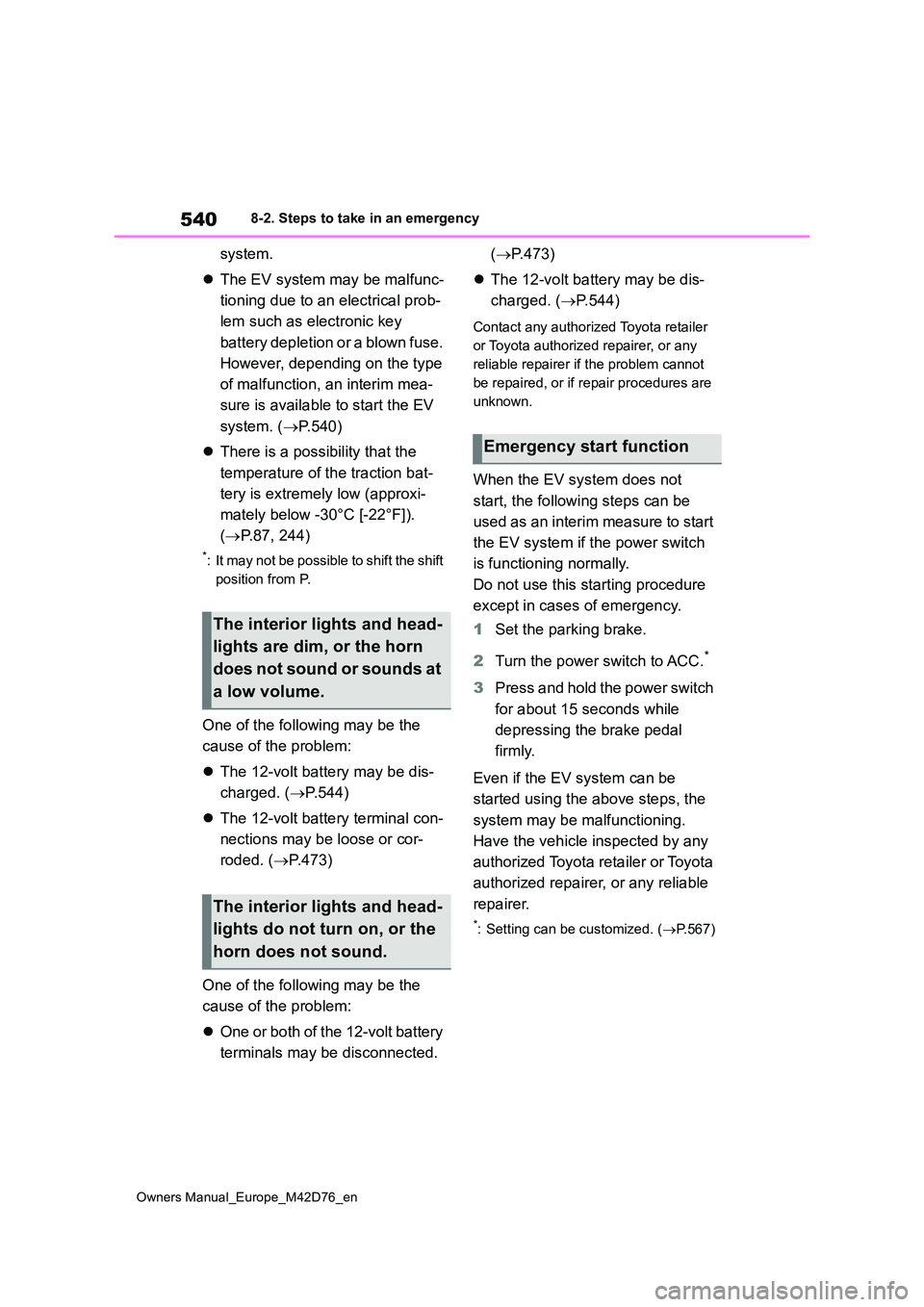
540
Owners Manual_Europe_M42D76_en
8-2. Steps to take in an emergency
system.
The EV system may be malfunc-
tioning due to an electrical prob-
lem such as electronic key
battery depletion or a blown fuse.
However, depending on the type
of malfunction, an interim mea-
sure is available to start the EV
system. ( P.540)
There is a possibility that the
temperature of the traction bat-
tery is extremely low (approxi-
mately below -30°C [-22°F]).
( P.87, 244)
*: It may not be possible to shift the shift
position from P.
One of the following may be the
cause of the problem:
The 12-volt battery may be dis-
charged. ( P.544)
The 12-volt battery terminal con-
nections may be loose or cor-
roded. ( P.473)
One of the following may be the
cause of the problem:
One or both of the 12-volt battery
terminals may be disconnected.
( P.473)
The 12-volt battery may be dis-
charged. ( P.544)
Contact any authorized Toyota retailer
or Toyota authorized repairer, or any
reliable repairer if the problem cannot
be repaired, or if repair procedures are
unknown.
When the EV system does not
start, the following steps can be
used as an interim measure to start
the EV system if the power switch
is functioning normally.
Do not use this starting procedure
except in cases of emergency.
1 Set the parking brake.
2 Turn the power switch to ACC.*
3Press and hold the power switch
for about 15 seconds while
depressing the brake pedal
firmly.
Even if the EV system can be
started using the above steps, the
system may be malfunctioning.
Have the vehicle inspected by any
authorized Toyota retailer or Toyota
authorized repairer, or any reliable
repairer.
*: Setting can be customized. ( P.567)
The interior lights and head-
lights are dim, or the horn
does not sound or sounds at
a low volume.
The interior lights and head-
lights do not turn on, or the
horn does not sound.
Emergency start function
Page 543 of 674
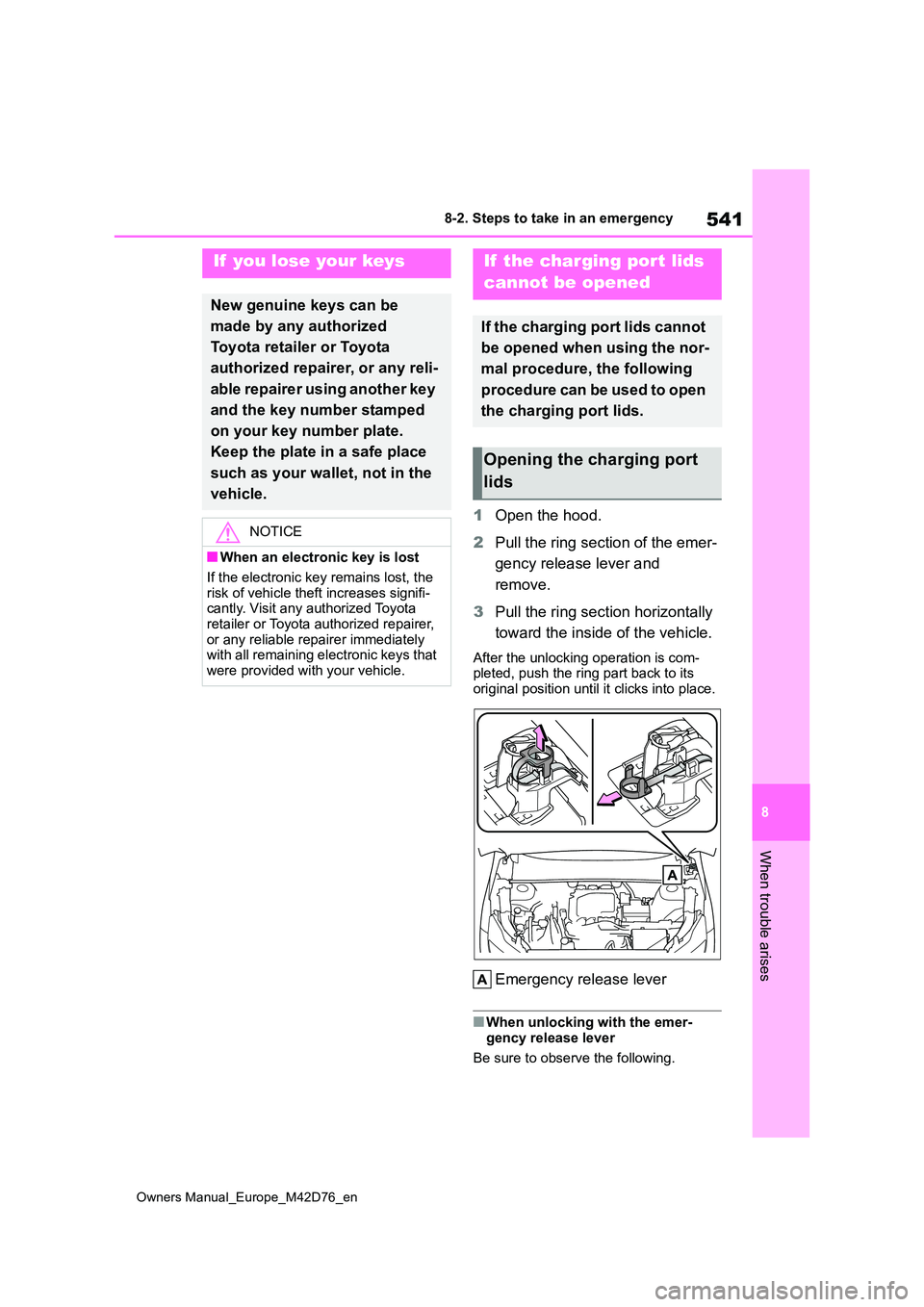
541
8
Owners Manual_Europe_M42D76_en
8-2. Steps to take in an emergency
When trouble arises
1Open the hood.
2 Pull the ring section of the emer-
gency release lever and
remove.
3 Pull the ring section horizontally
toward the inside of the vehicle.
After the unlocking operation is com- pleted, push the ring part back to its
original position until it clicks into place.
Emergency release lever
■When unlocking with the emer- gency release lever
Be sure to observe the following.
If you lose your keys
New genuine keys can be
made by any authorized
Toyota retailer or Toyota
authorized repairer, or any reli-
able repairer using another key
and the key number stamped
on your key number plate.
Keep the plate in a safe place
such as your wallet, not in the
vehicle.
NOTICE
■When an electronic key is lost
If the electronic key remains lost, the
risk of vehicle theft increases signifi- cantly. Visit any authorized Toyota retailer or Toyota authorized repairer,
or any reliable repairer immediately with all remaining electronic keys that were provided with your vehicle.
If the charging port lids
cannot be opened
If the charging port lids cannot
be opened when using the nor-
mal procedure, the following
procedure can be used to open
the charging port lids.
Opening the charging port
lids
Page 544 of 674
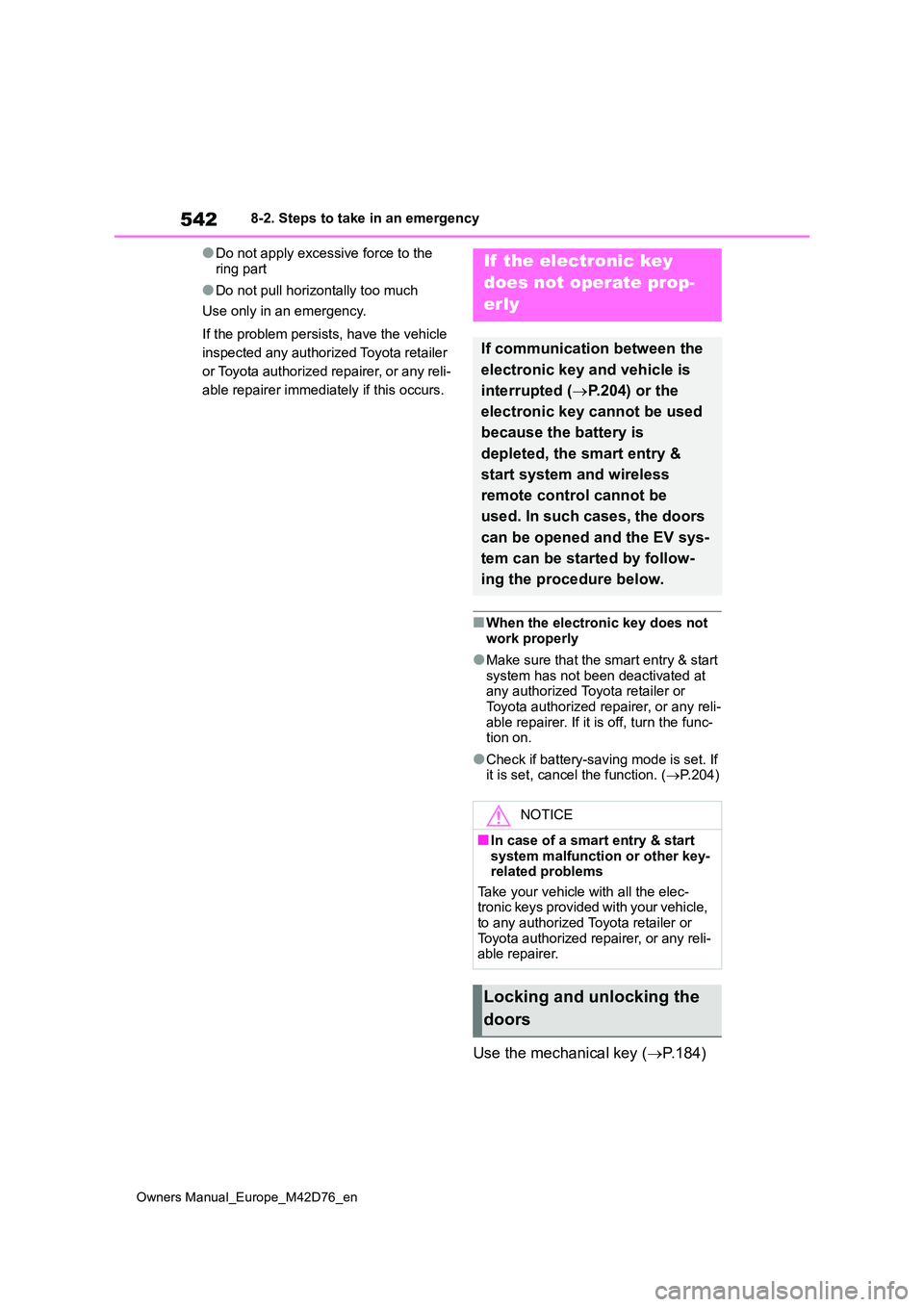
542
Owners Manual_Europe_M42D76_en
8-2. Steps to take in an emergency
●Do not apply excessive force to the
ring part
●Do not pull horizontally too much
Use only in an emergency.
If the problem persists, have the vehicle
inspected any authorized Toyota retailer
or Toyota authorized repairer, or any reli-
able repairer immediately if this occurs.
■When the electronic key does not work properly
●Make sure that the smart entry & start system has not been deactivated at any authorized Toyota retailer or
Toyota authorized repairer, or any reli- able repairer. If it is off, turn the func-tion on.
●Check if battery-saving mode is set. If it is set, cancel the function. ( P.204)
Use the mechanical key (P.184)
If the electronic key
does not operate prop-
erly
If communication between the
electronic key and vehicle is
interrupted ( P.204) or the
electronic key cannot be used
because the battery is
depleted, the smart entry &
start system and wireless
remote control cannot be
used. In such cases, the doors
can be opened and the EV sys-
tem can be started by follow-
ing the procedure below.
NOTICE
■In case of a smart entry & start system malfunction or other key-related problems
Take your vehicle with all the elec- tronic keys provided with your vehicle, to any authorized Toyota retailer or
Toyota authorized repairer, or any reli- able repairer.
Locking and unlocking the
doors
Page 545 of 674
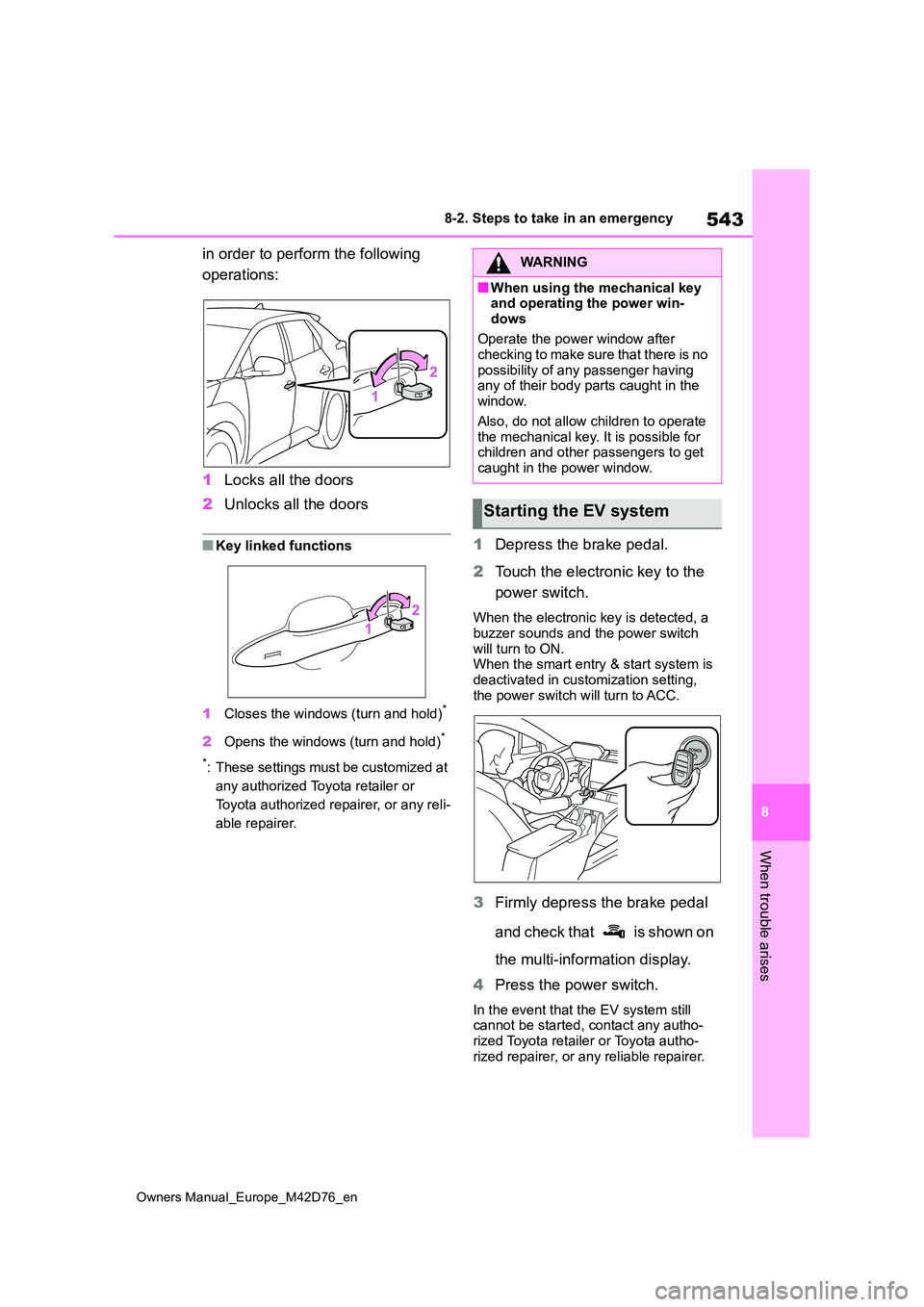
543
8
Owners Manual_Europe_M42D76_en
8-2. Steps to take in an emergency
When trouble arises
in order to perform the following
operations:
1 Locks all the doors
2 Unlocks all the doors
■Key linked functions
1 Closes the windows (turn and hold)*
2Opens the windows (turn and hold)*
*: These settings must be customized at
any authorized Toyota retailer or
Toyota authorized repairer, or any reli-
able repairer.
1 Depress the brake pedal.
2 Touch the electronic key to the
power switch.
When the electronic key is detected, a buzzer sounds and the power switch
will turn to ON. When the smart entry & start system is deactivated in customization setting,
the power switch will turn to ACC.
3 Firmly depress the brake pedal
and check that is shown on
the multi-information display.
4 Press the power switch.
In the event that the EV system still cannot be started, contact any autho-rized Toyota retailer or Toyota autho-
rized repairer, or any reliable repairer.
WARNING
■When using the mechanical key and operating the power win-
dows
Operate the power window after checking to make sure that there is no
possibility of any passenger having any of their body parts caught in the window.
Also, do not allow children to operate the mechanical key. It is possible for children and other passengers to get
caught in the power window.
Starting the EV system
Page 546 of 674

544
Owners Manual_Europe_M42D76_en
8-2. Steps to take in an emergency
■Stopping the EV system
Set the parking brake, shift the shift
position to P and press the power switch as you normally do when stopping the EV system.
■Electronic key battery
As the above procedure is a temporary measure, it is recommended that the electronic key battery be replaced
immediately when the battery is depleted. ( P.499)
■Alarm (if equipped)
Using the mechanical key to lock the
doors will not set the alarm system. If a door is unlocked using the mechani-cal key when the alarm system is set,
the alarm may be triggered. ( P. 7 7 )
■Changing power switch modes
Release the brake pedal and press the power switch in step 3 above.
The EV system does not start and modes will be changed each time the switch is pressed. ( P.246)
If you have a set of jumper (or
booster) cables and a second vehi-
cle with a 12-volt battery, you can
jump start your vehicle by following
the steps below.
1 Confirm that the electronic key
is being carried.
When connecting the jumper (or
booster) cables, depending on the situ- ation, the alarm may activate and the doors may lock. ( P.78)
2Open the hood (P.467).
3 Open the positive (+) battery ter-
minal cover.
While pressing on the claw, open the
If the 12-volt batter y is
discharged
The following procedures may
be used to start the EV system
if the vehicle’s 12-volt battery
is discharged.
You can also call any autho-
rized Toyota retailer or Toyota
authorized repairer, or any reli-
able repairer.
Restarting the EV system
Page 547 of 674
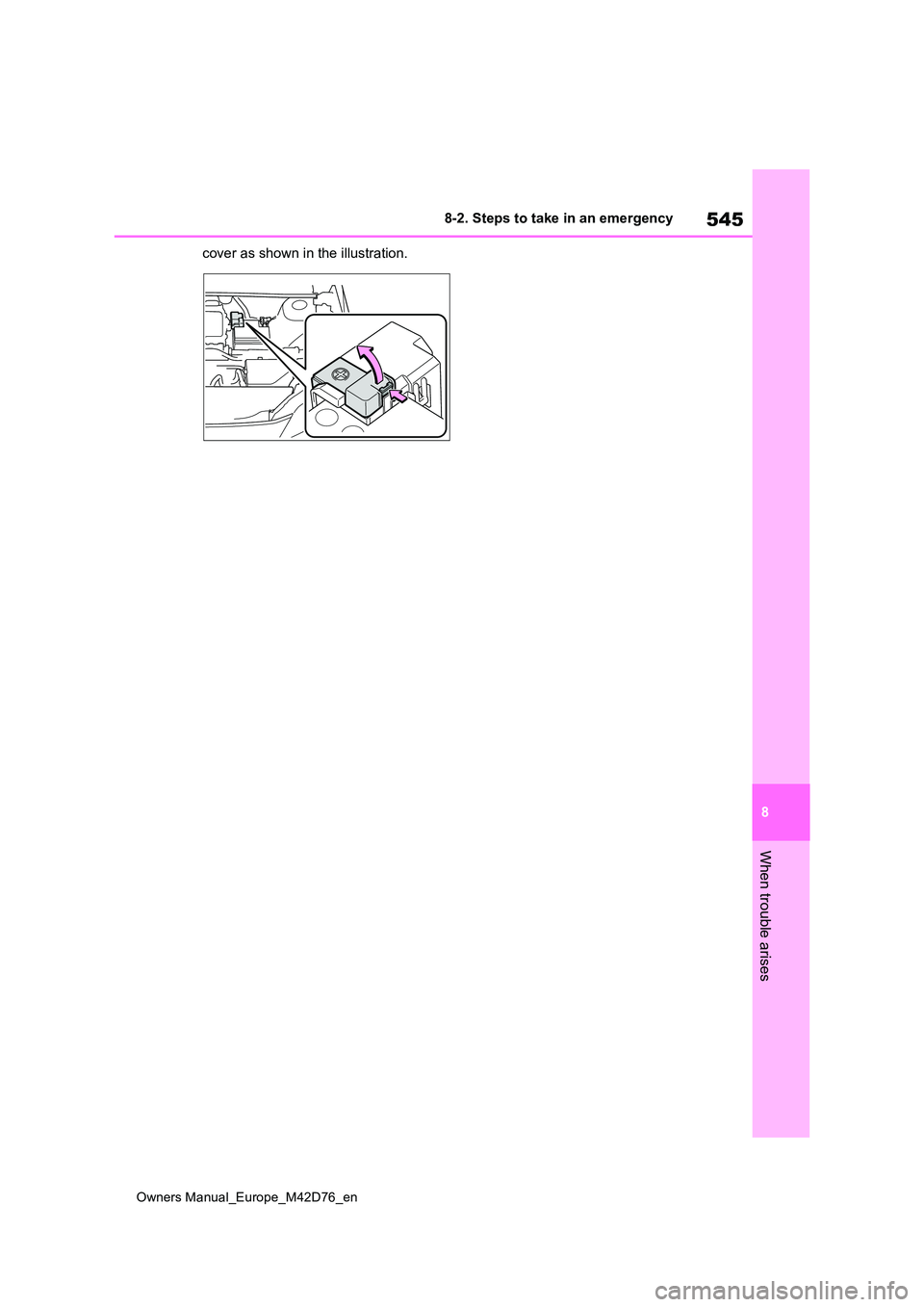
545
8
Owners Manual_Europe_M42D76_en
8-2. Steps to take in an emergency
When trouble arises
cover as shown in the illustration.
Page 548 of 674
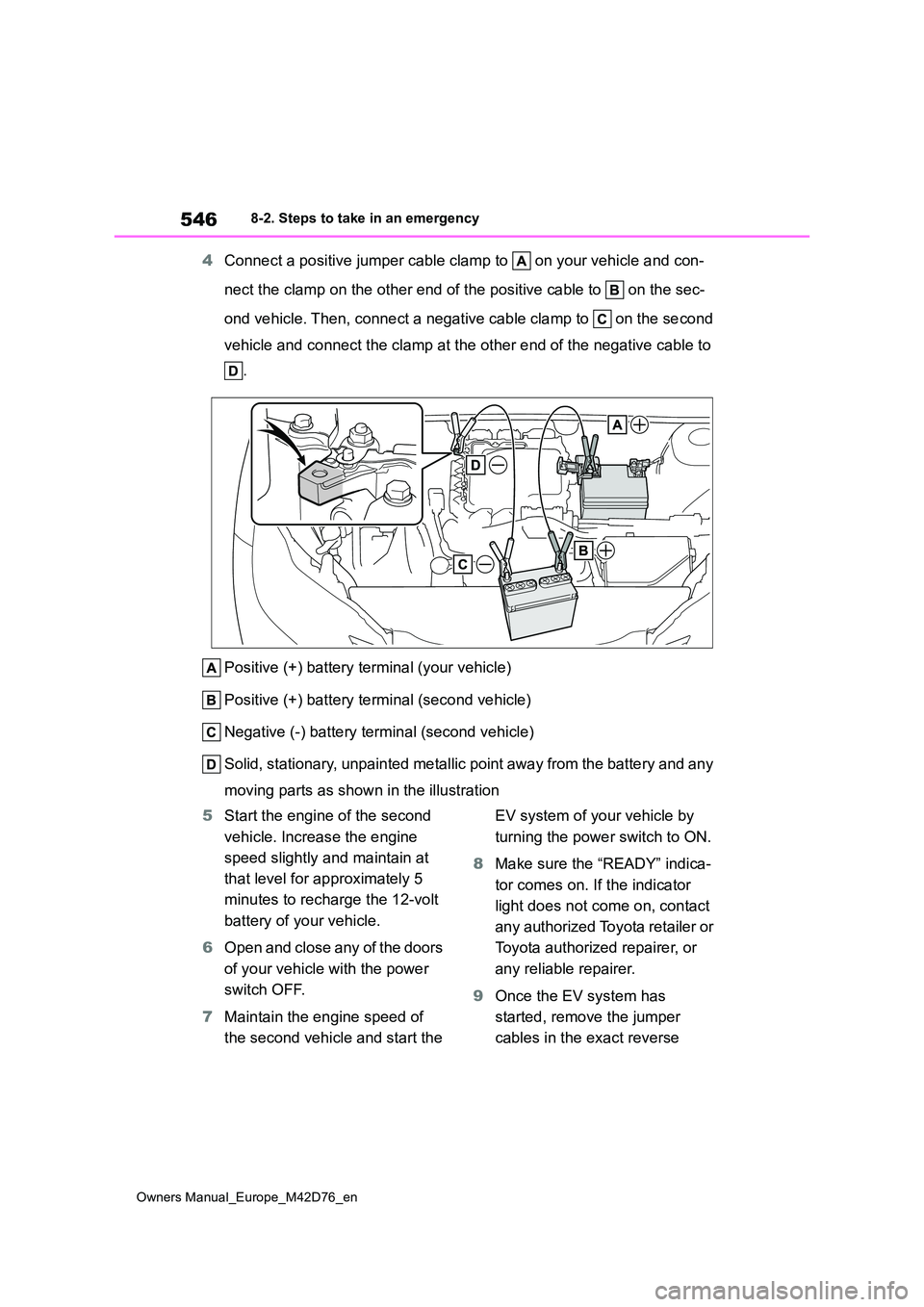
546
Owners Manual_Europe_M42D76_en
8-2. Steps to take in an emergency
4Connect a positive jumper cable clamp to on your vehicle and con-
nect the clamp on the other end of the positive cable to on th e sec-
ond vehicle. Then, connect a negative cable clamp to on the se cond
vehicle and connect the clamp at the other end of the negative cable to
.
Positive (+) battery terminal (your vehicle)
Positive (+) battery terminal (second vehicle)
Negative (-) battery terminal (second vehicle)
Solid, stationary, unpainted metallic point away from the batte ry and any
moving parts as shown in the illustration
5 Start the engine of the second
vehicle. Increase the engine
speed slightly and maintain at
that level for approximately 5
minutes to recharge the 12-volt
battery of your vehicle.
6 Open and close any of the doors
of your vehicle with the power
switch OFF.
7 Maintain the engine speed of
the second vehicle and start the
EV system of your vehicle by
turning the power switch to ON.
8 Make sure the “READY” indica-
tor comes on. If the indicator
light does not come on, contact
any authorized Toyota retailer or
Toyota authorized repairer, or
any reliable repairer.
9 Once the EV system has
started, remove the jumper
cables in the exact reverse
Page 549 of 674
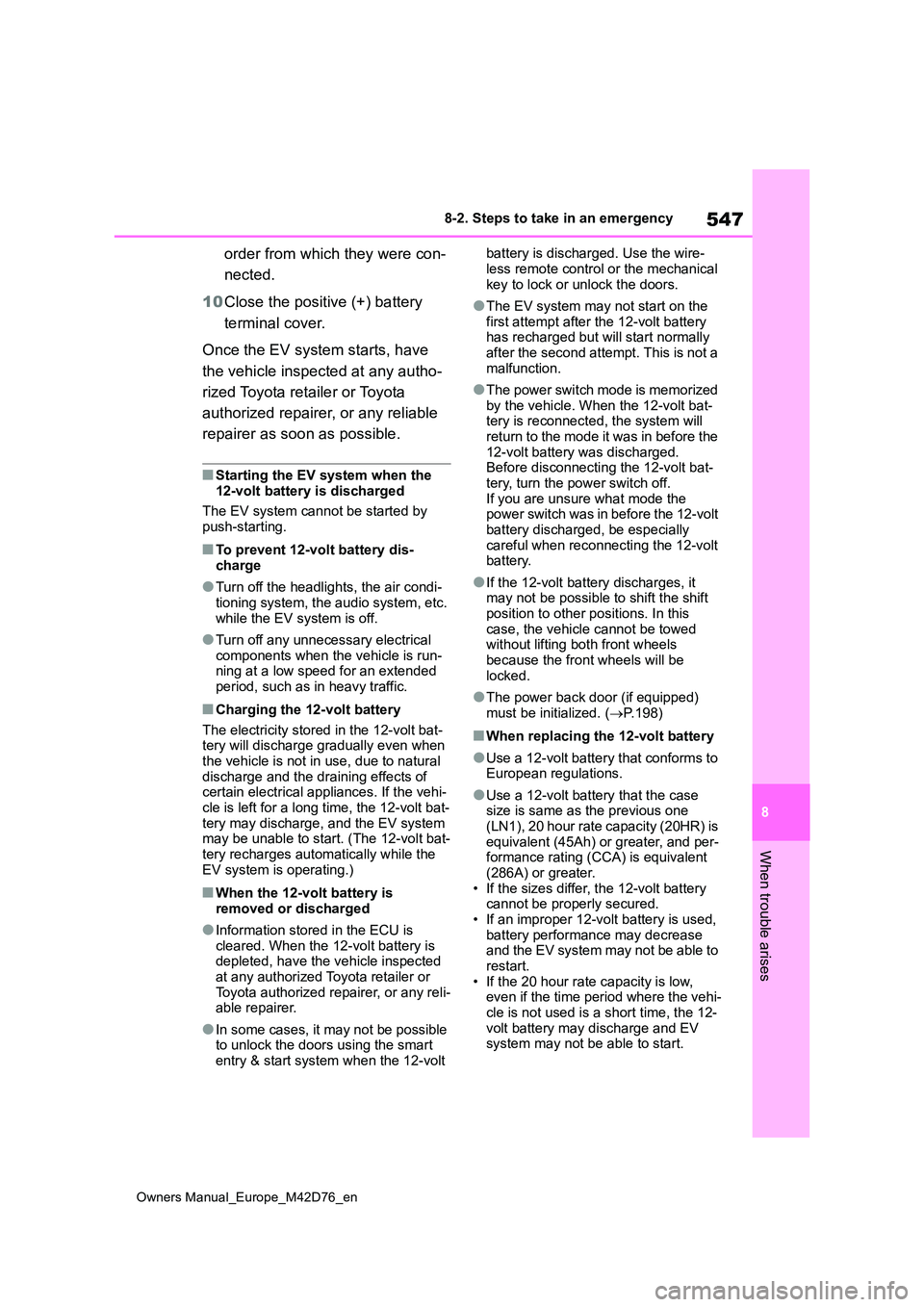
547
8
Owners Manual_Europe_M42D76_en
8-2. Steps to take in an emergency
When trouble arises
order from which they were con-
nected.
10 Close the positive (+) battery
terminal cover.
Once the EV system starts, have
the vehicle inspected at any autho-
rized Toyota retailer or Toyota
authorized repairer, or any reliable
repairer as soon as possible.
■Starting the EV system when the 12-volt battery is discharged
The EV system cannot be started by push-starting.
■To prevent 12-volt battery dis-charge
●Turn off the headlights, the air condi-tioning system, the audio system, etc.
while the EV system is off.
●Turn off any unnecessary electrical
components when the vehicle is run- ning at a low speed for an extended period, such as in heavy traffic.
■Charging the 12-volt battery
The electricity stored in the 12-volt bat- tery will discharge gradually even when the vehicle is not in use, due to natural
discharge and the draining effects of certain electrical appliances. If the vehi-cle is left for a long time, the 12-volt bat-
tery may discharge, and the EV system may be unable to start. (The 12-volt bat-tery recharges automatically while the
EV system is operating.)
■When the 12-volt battery is removed or discharged
●Information stored in the ECU is cleared. When the 12-volt battery is depleted, have the vehicle inspected
at any authorized Toyota retailer or Toyota authorized repairer, or any reli-able repairer.
●In some cases, it may not be possible to unlock the doors using the smart
entry & start system when the 12-volt
battery is discharged. Use the wire-
less remote control or the mechanical key to lock or unlock the doors.
●The EV system may not start on the first attempt after the 12-volt battery has recharged but will start normally
after the second attempt. This is not a malfunction.
●The power switch mode is memorized by the vehicle. When the 12-volt bat-tery is reconnected, the system will
return to the mode it was in before the 12-volt battery was discharged. Before disconnecting the 12-volt bat-
tery, turn the power switch off. If you are unsure what mode the power switch was in before the 12-volt
battery discharged, be especially careful when reconnecting the 12-volt battery.
●If the 12-volt battery discharges, it may not be possible to shift the shift
position to other positions. In this case, the vehicle cannot be towed without lifting both front wheels
because the front wheels will be locked.
●The power back door (if equipped) must be initialized. ( P.198)
■When replacing the 12-volt battery
●Use a 12-volt battery that conforms to European regulations.
●Use a 12-volt battery that the case size is same as the previous one (LN1), 20 hour rate capacity (20HR) is
equivalent (45Ah) or greater, and per- formance rating (CCA) is equivalent (286A) or greater.
• If the sizes differ, the 12-volt battery cannot be properly secured.• If an improper 12-volt battery is used,
battery performance may decrease and the EV system may not be able to restart.
• If the 20 hour rate capacity is low, even if the time period where the vehi-cle is not used is a short time, the 12-
volt battery may discharge and EV system may not be able to start.
Page 550 of 674
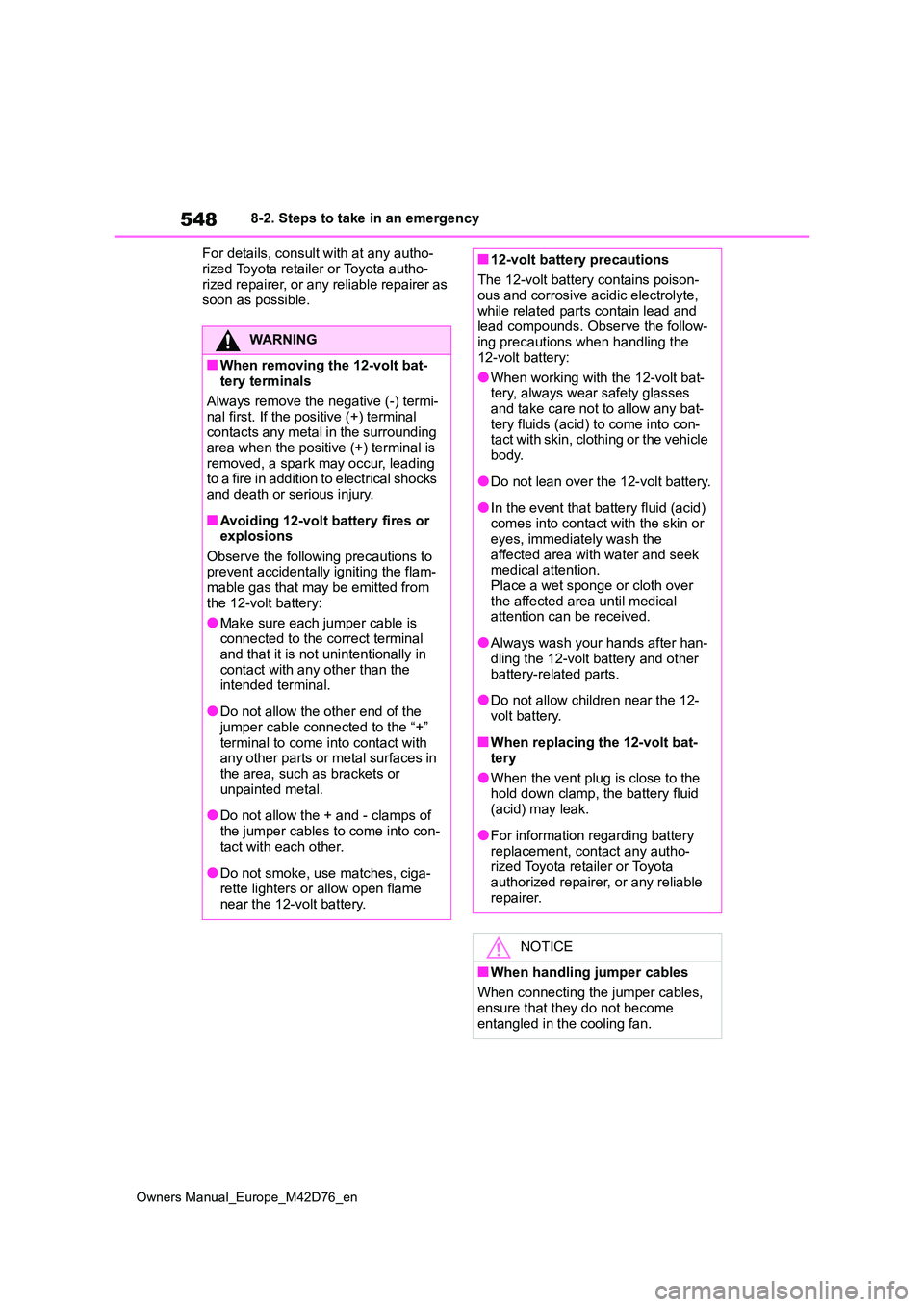
548
Owners Manual_Europe_M42D76_en
8-2. Steps to take in an emergency
For details, consult with at any autho-
rized Toyota retailer or Toyota autho- rized repairer, or any reliable repairer as soon as possible.
WARNING
■When removing the 12-volt bat-tery terminals
Always remove the negative (-) termi-
nal first. If the positive (+) terminal contacts any metal in the surrounding area when the positive (+) terminal is
removed, a spark may occur, leading to a fire in addition to electrical shocks and death or serious injury.
■Avoiding 12-volt battery fires or explosions
Observe the following precautions to prevent accidentally igniting the flam-mable gas that may be emitted from
the 12-volt battery:
●Make sure each jumper cable is connected to the correct terminal
and that it is not unintentionally in contact with any other than the intended terminal.
●Do not allow the other end of the jumper cable connected to the “+”
terminal to come into contact with any other parts or metal surfaces in the area, such as brackets or
unpainted metal.
●Do not allow the + and - clamps of
the jumper cables to come into con- tact with each other.
●Do not smoke, use matches, ciga-rette lighters or allow open flame near the 12-volt battery.
■12-volt battery precautions
The 12-volt battery contains poison- ous and corrosive acidic electrolyte,
while related parts contain lead and lead compounds. Observe the follow-ing precautions when handling the
12-volt battery:
●When working with the 12-volt bat- tery, always wear safety glasses
and take care not to allow any bat- tery fluids (acid) to come into con-tact with skin, clothing or the vehicle
body.
●Do not lean over the 12-volt battery.
●In the event that battery fluid (acid) comes into contact with the skin or
eyes, immediately wash the affected area with water and seek medical attention.
Place a wet sponge or cloth over the affected area until medical attention can be received.
●Always wash your hands after han-dling the 12-volt battery and other
battery-related parts.
●Do not allow children near the 12-
volt battery.
■When replacing the 12-volt bat-
tery
●When the vent plug is close to the hold down clamp, the battery fluid
(acid) may leak.
●For information regarding battery
replacement, contact any autho- rized Toyota retailer or Toyota authorized repairer, or any reliable
repairer.
NOTICE
■When handling jumper cables
When connecting the jumper cables,
ensure that they do not become entangled in the cooling fan.